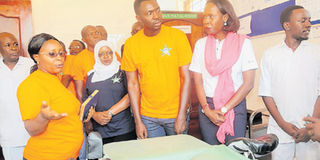Worrying reproductive health state in Kigoma

A senior midwife at Mwakizega Dispensary in Uvinza District, Kigoma Region, Ms Mary Tuakazi, explains to the Deputy Health Minister, Dr Hamis Kigwangalla during the handover ceremony of 26 dispensaries built by EngenderHealth and financed by Bloomberg Philanthropies at a cost of Sh 2.7 billion.
PHOTO | SYRIACUS BUGUZI.
What you need to know:
- Among women of the reproductive age (15-49 years), in the region, only 17 per cent received ante-natal care during their first three months of pregnancy, according to a latest survey carried out by the US Department for Health and Human Services.
The state of reproductive health services in Tanzania’s western region of Kigoma leaves much to be desired, despite the huge investment by the government and donor agencies.
Among women of the reproductive age (15-49 years), in the region, only 17 per cent received ante-natal care during their first three months of pregnancy, according to a latest survey carried out by the US Department for Health and Human Services.
The survey, done under the auspices of the Centre for Diseases Control and Prevention (CDC), revealed further that only 13 percent of the women attended post-natal check-up for their health.
The findings disseminated in 2015 paint a gloomy picture of the state of reproductive health services especially in reference to the high infant mortality rates in the region and the entire country.
The government and donor agencies believe that time is now to scale up more investment in the Kigoma’s reproductive health services in order to reverse the trend of maternal and child deaths.
The country’s ‘National Road Map Strategic Plan to Accelerate Reduction of Maternal, Newborn and Child Deaths in Tanzania (2008-2015) is explicit on what should be done. However, there is something to note in the plan, despite the achievements that have already been documented as efforts by stakeholders.
In the plan, it can be noted that although significant progress has been made in reducing child mortality, neonatal mortality remains high at 32 per 1,000 live births, which accounts for 47 per cent of infant mortality rate, estimated at 68 per 1,000 live births.
Things to address
It has been found in the survey that reproductive health situation is exacerbated by health system factors such as inadequate implementation of pro-poor policies, weak health infrastructure, limited access to quality health services, inadequate human resource, and shortage of skilled health providers.
The weak referral systems have also been a critical factor, in addition to low utilization of modern family planning services, lack of equipment and supplies, weak health management at all levels and inadequate coordination between public and private facilities.
But there are non-health system factors like inadequate community involvement and participation in planning, implementation, monitoring and evaluation of health services, some social cultural beliefs and practices, gender inequality, weak educational sector and poor health seeking behaviour.
What’s being done to rescue the situation
This month, EngenderHealth Tanzania, through Bloomberg Philanthropies & Fondation H&B Agerup support, handed over 26 health facilities that they had built and renovated in Kigoma Region.
This was aimed at boosting the access to quality family planning and other reproductive health services in Kigoma region through expanding availability of comprehensive emergency obstetric and neonatal care.
The broader aim was also to increase comprehensive post abortion care and family planning services, with emphasis on long acting reversible contraception and permanent methods in the region.
This involved constructing and equipping of maternity buildings that include labour wards, antenatal and postnatal clinics, rooms to provide service to women with post abortion complications and family planning as well as maternity wards in 24 dispensaries.
The total cost for the support is worth $1,342,144 in which $ 1,138,244 was used for construction and renovation, and $203,900 for procurement of equipment.
These were collaborative efforts of the Ministry of Health, Community Development, Gender, Elderly and Children (MoHCGEC), Thamini Uhai, the U.S. Centre for Disease Control and Prevention (CDC), Engender Health and local government authorities.
According to Deputy Minister for Health, Community Development, Gender, Elderly and Children, Dr Hamisi Kigwangalla the need to expand the services in Kigoma now requires the support of more stakeholders. “We call upon other stakeholders and well-wishers to come up and offer similar support in other regions,’’ said Dr Kigwangala during the handover event in the region.
There are still some gaps that the government can fill in an effort to improve the services, said the Bloomberg Philanthropies Representative Dr Godson Maro.
“We urge the government to put more efforts on the anesthesiology cadre that is highly needed in every facility that is providing surgical services. The number available in Kigoma is very inadequate,’’ said Dr Maro.
He said, “We have been working in the country since 2006. During that time, we have managed to achieve a lot including upgrading of a total 17 health centres that are now offering labour/maternal and neonatal services and thus contributing to reduce the number of maternal deaths.
Email: [email protected]




